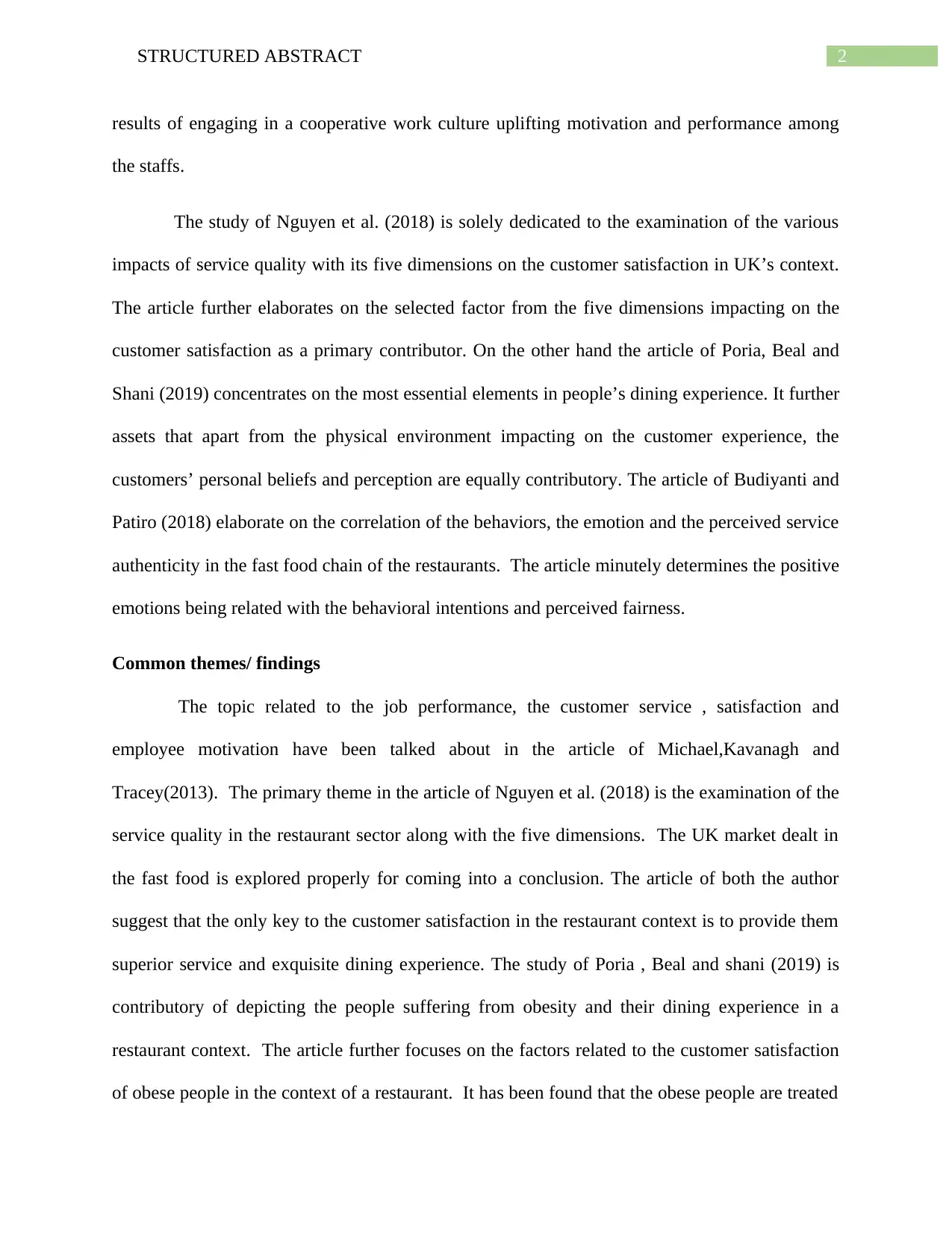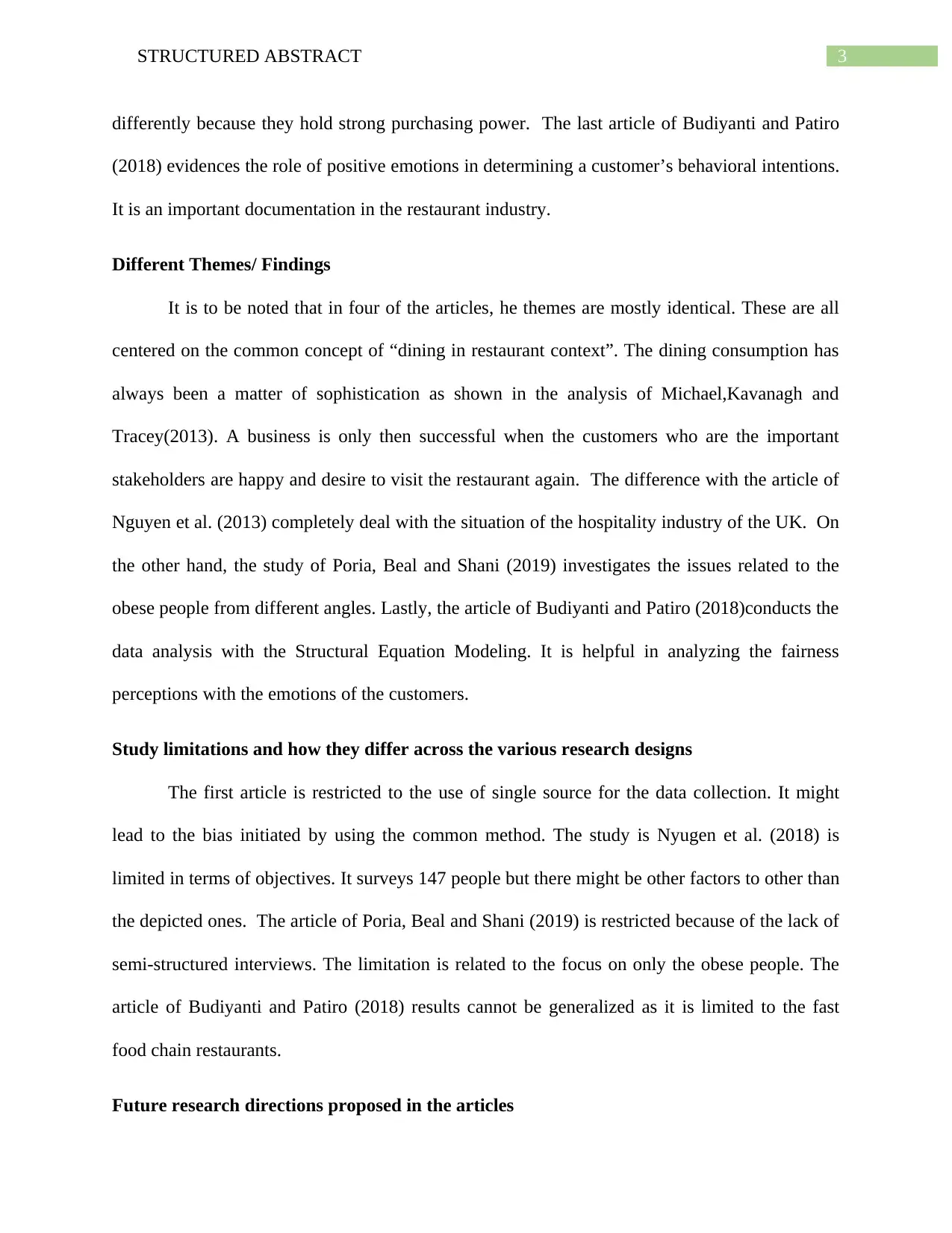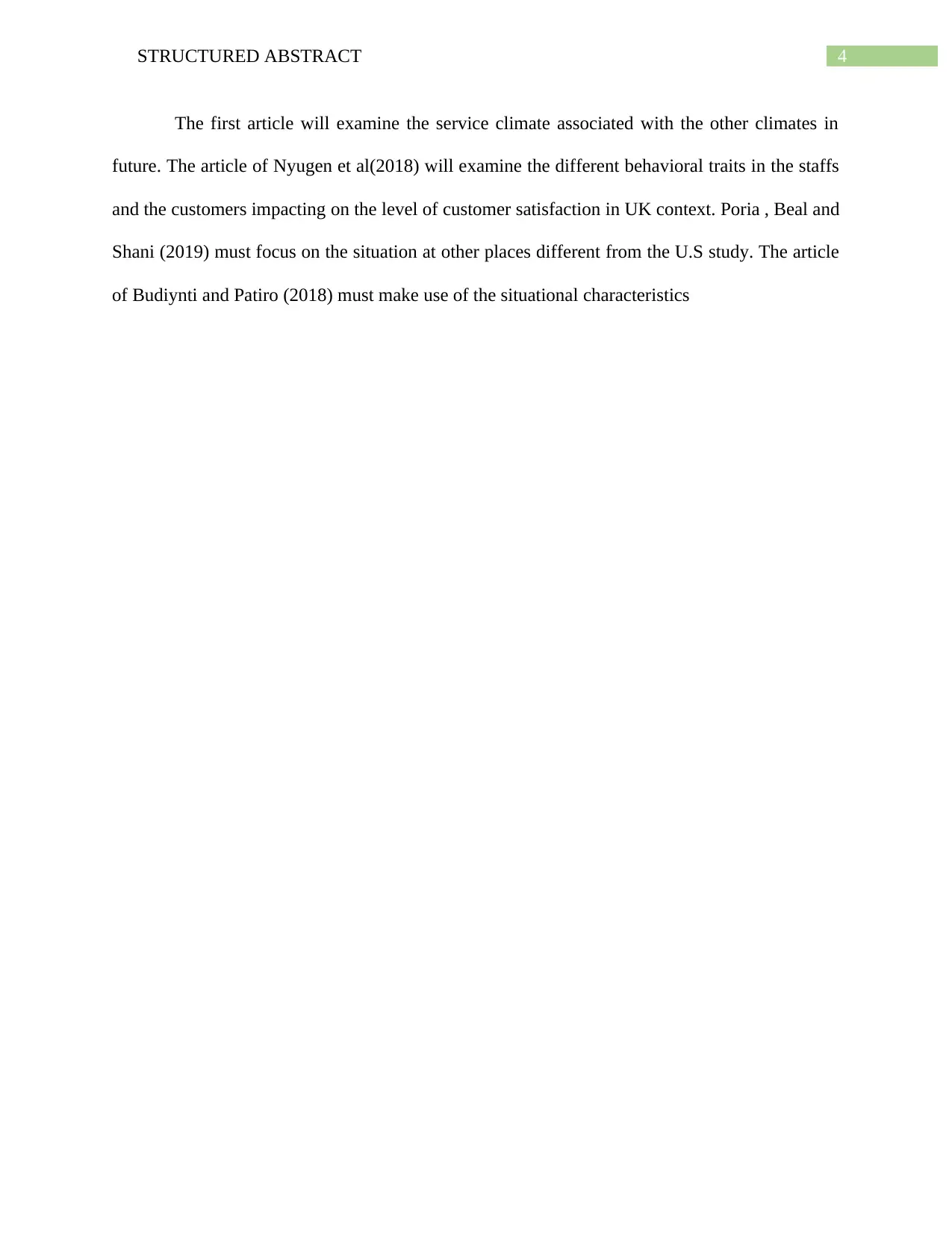Business Research Methods (BMO 6630) Structured Abstract Analysis
VerifiedAdded on 2023/02/01
|6
|1335
|55
Report
AI Summary
This structured abstract reviews the topic of dining consumption in the restaurant context, analyzing articles by Michael, Kavanagh, and Tracey; Nguyen, Nisar, and Knox; Poria, Beal, and Shani; and Budiyanti and Patiro. The abstract explores themes of customer service, satisfaction, and employee motivation within the hospitality industry, particularly restaurants. It discusses common themes such as service quality and customer experience, as well as differing perspectives on obese diners and the impact of emotions on customer behavior. The analysis also highlights study limitations, including data collection methods and generalizability, and suggests future research directions focusing on service climate, behavioral traits, and situational characteristics. The abstract provides a comprehensive overview of the current research landscape in dining consumption and identifies potential areas for further investigation.

Running Head : STRUCTURED ABSTRACT
Structured Abstract
Nam of the Student
Name of the University
Author Note
Structured Abstract
Nam of the Student
Name of the University
Author Note
Paraphrase This Document
Need a fresh take? Get an instant paraphrase of this document with our AI Paraphraser

1STRUCTURED ABSTRACT
BMO 6630 : Business Research Methods
Assessment 01 : Articles Collection &Structured Abstract
The aim of this structured abstract is to review the topic of “ Dining Consumption in Restaurant
Context”. The articles which are used for exploring the topic are written by (i) John W. Michael,
Michael J. Kavanagh and J. Bruce Tracey (ii)Quang Nguyen, Tahir M. Nisar and Dan Knox (iii)
Yaniv Poria, Jeremy Beal and Amir Shani. (iv) Hety Budiyanti and Shine Pintor Siolemba
Patiro.
Brief summary of the Theory and discussion of progression in the field
The hospitality industry especially the restaurant industry is a huge sector where there are
certain factor which need to be maintained and focused on. Since, this is a highly competitive
industry and there are potential market players, a particular restaurant should be aware of the
customer demands and work accordingly. In the article of John W. Michael (2013) the main
topic of concern is the influence of supportive work practices on the customer-contact
employees’ motivation, behavior and perception. The author of the past literature are well
informed about the specific operation related barriers the customer-contact employees face in the
restaurant context. Surprisingly they are unaware of the fact that the work environment also
affect rather shape the performance, motivation and retention of the employees.
The article of Michael, Kavanagh and Tracey (2013)works on the customers; perceptions
on a restaurant’s services. The service-climate perceptions along with the staff service have been
presented in the findings. Since, the hospitality industry is a flourishing industry, the sustenance
in the market is often based on the competitive advantage gained through serving the customers
in the best possible manner. The present study is a well document demonstrating the positive
BMO 6630 : Business Research Methods
Assessment 01 : Articles Collection &Structured Abstract
The aim of this structured abstract is to review the topic of “ Dining Consumption in Restaurant
Context”. The articles which are used for exploring the topic are written by (i) John W. Michael,
Michael J. Kavanagh and J. Bruce Tracey (ii)Quang Nguyen, Tahir M. Nisar and Dan Knox (iii)
Yaniv Poria, Jeremy Beal and Amir Shani. (iv) Hety Budiyanti and Shine Pintor Siolemba
Patiro.
Brief summary of the Theory and discussion of progression in the field
The hospitality industry especially the restaurant industry is a huge sector where there are
certain factor which need to be maintained and focused on. Since, this is a highly competitive
industry and there are potential market players, a particular restaurant should be aware of the
customer demands and work accordingly. In the article of John W. Michael (2013) the main
topic of concern is the influence of supportive work practices on the customer-contact
employees’ motivation, behavior and perception. The author of the past literature are well
informed about the specific operation related barriers the customer-contact employees face in the
restaurant context. Surprisingly they are unaware of the fact that the work environment also
affect rather shape the performance, motivation and retention of the employees.
The article of Michael, Kavanagh and Tracey (2013)works on the customers; perceptions
on a restaurant’s services. The service-climate perceptions along with the staff service have been
presented in the findings. Since, the hospitality industry is a flourishing industry, the sustenance
in the market is often based on the competitive advantage gained through serving the customers
in the best possible manner. The present study is a well document demonstrating the positive

2STRUCTURED ABSTRACT
results of engaging in a cooperative work culture uplifting motivation and performance among
the staffs.
The study of Nguyen et al. (2018) is solely dedicated to the examination of the various
impacts of service quality with its five dimensions on the customer satisfaction in UK’s context.
The article further elaborates on the selected factor from the five dimensions impacting on the
customer satisfaction as a primary contributor. On the other hand the article of Poria, Beal and
Shani (2019) concentrates on the most essential elements in people’s dining experience. It further
assets that apart from the physical environment impacting on the customer experience, the
customers’ personal beliefs and perception are equally contributory. The article of Budiyanti and
Patiro (2018) elaborate on the correlation of the behaviors, the emotion and the perceived service
authenticity in the fast food chain of the restaurants. The article minutely determines the positive
emotions being related with the behavioral intentions and perceived fairness.
Common themes/ findings
The topic related to the job performance, the customer service , satisfaction and
employee motivation have been talked about in the article of Michael,Kavanagh and
Tracey(2013). The primary theme in the article of Nguyen et al. (2018) is the examination of the
service quality in the restaurant sector along with the five dimensions. The UK market dealt in
the fast food is explored properly for coming into a conclusion. The article of both the author
suggest that the only key to the customer satisfaction in the restaurant context is to provide them
superior service and exquisite dining experience. The study of Poria , Beal and shani (2019) is
contributory of depicting the people suffering from obesity and their dining experience in a
restaurant context. The article further focuses on the factors related to the customer satisfaction
of obese people in the context of a restaurant. It has been found that the obese people are treated
results of engaging in a cooperative work culture uplifting motivation and performance among
the staffs.
The study of Nguyen et al. (2018) is solely dedicated to the examination of the various
impacts of service quality with its five dimensions on the customer satisfaction in UK’s context.
The article further elaborates on the selected factor from the five dimensions impacting on the
customer satisfaction as a primary contributor. On the other hand the article of Poria, Beal and
Shani (2019) concentrates on the most essential elements in people’s dining experience. It further
assets that apart from the physical environment impacting on the customer experience, the
customers’ personal beliefs and perception are equally contributory. The article of Budiyanti and
Patiro (2018) elaborate on the correlation of the behaviors, the emotion and the perceived service
authenticity in the fast food chain of the restaurants. The article minutely determines the positive
emotions being related with the behavioral intentions and perceived fairness.
Common themes/ findings
The topic related to the job performance, the customer service , satisfaction and
employee motivation have been talked about in the article of Michael,Kavanagh and
Tracey(2013). The primary theme in the article of Nguyen et al. (2018) is the examination of the
service quality in the restaurant sector along with the five dimensions. The UK market dealt in
the fast food is explored properly for coming into a conclusion. The article of both the author
suggest that the only key to the customer satisfaction in the restaurant context is to provide them
superior service and exquisite dining experience. The study of Poria , Beal and shani (2019) is
contributory of depicting the people suffering from obesity and their dining experience in a
restaurant context. The article further focuses on the factors related to the customer satisfaction
of obese people in the context of a restaurant. It has been found that the obese people are treated
⊘ This is a preview!⊘
Do you want full access?
Subscribe today to unlock all pages.

Trusted by 1+ million students worldwide

3STRUCTURED ABSTRACT
differently because they hold strong purchasing power. The last article of Budiyanti and Patiro
(2018) evidences the role of positive emotions in determining a customer’s behavioral intentions.
It is an important documentation in the restaurant industry.
Different Themes/ Findings
It is to be noted that in four of the articles, he themes are mostly identical. These are all
centered on the common concept of “dining in restaurant context”. The dining consumption has
always been a matter of sophistication as shown in the analysis of Michael,Kavanagh and
Tracey(2013). A business is only then successful when the customers who are the important
stakeholders are happy and desire to visit the restaurant again. The difference with the article of
Nguyen et al. (2013) completely deal with the situation of the hospitality industry of the UK. On
the other hand, the study of Poria, Beal and Shani (2019) investigates the issues related to the
obese people from different angles. Lastly, the article of Budiyanti and Patiro (2018)conducts the
data analysis with the Structural Equation Modeling. It is helpful in analyzing the fairness
perceptions with the emotions of the customers.
Study limitations and how they differ across the various research designs
The first article is restricted to the use of single source for the data collection. It might
lead to the bias initiated by using the common method. The study is Nyugen et al. (2018) is
limited in terms of objectives. It surveys 147 people but there might be other factors to other than
the depicted ones. The article of Poria, Beal and Shani (2019) is restricted because of the lack of
semi-structured interviews. The limitation is related to the focus on only the obese people. The
article of Budiyanti and Patiro (2018) results cannot be generalized as it is limited to the fast
food chain restaurants.
Future research directions proposed in the articles
differently because they hold strong purchasing power. The last article of Budiyanti and Patiro
(2018) evidences the role of positive emotions in determining a customer’s behavioral intentions.
It is an important documentation in the restaurant industry.
Different Themes/ Findings
It is to be noted that in four of the articles, he themes are mostly identical. These are all
centered on the common concept of “dining in restaurant context”. The dining consumption has
always been a matter of sophistication as shown in the analysis of Michael,Kavanagh and
Tracey(2013). A business is only then successful when the customers who are the important
stakeholders are happy and desire to visit the restaurant again. The difference with the article of
Nguyen et al. (2013) completely deal with the situation of the hospitality industry of the UK. On
the other hand, the study of Poria, Beal and Shani (2019) investigates the issues related to the
obese people from different angles. Lastly, the article of Budiyanti and Patiro (2018)conducts the
data analysis with the Structural Equation Modeling. It is helpful in analyzing the fairness
perceptions with the emotions of the customers.
Study limitations and how they differ across the various research designs
The first article is restricted to the use of single source for the data collection. It might
lead to the bias initiated by using the common method. The study is Nyugen et al. (2018) is
limited in terms of objectives. It surveys 147 people but there might be other factors to other than
the depicted ones. The article of Poria, Beal and Shani (2019) is restricted because of the lack of
semi-structured interviews. The limitation is related to the focus on only the obese people. The
article of Budiyanti and Patiro (2018) results cannot be generalized as it is limited to the fast
food chain restaurants.
Future research directions proposed in the articles
Paraphrase This Document
Need a fresh take? Get an instant paraphrase of this document with our AI Paraphraser

4STRUCTURED ABSTRACT
The first article will examine the service climate associated with the other climates in
future. The article of Nyugen et al(2018) will examine the different behavioral traits in the staffs
and the customers impacting on the level of customer satisfaction in UK context. Poria , Beal and
Shani (2019) must focus on the situation at other places different from the U.S study. The article
of Budiynti and Patiro (2018) must make use of the situational characteristics
The first article will examine the service climate associated with the other climates in
future. The article of Nyugen et al(2018) will examine the different behavioral traits in the staffs
and the customers impacting on the level of customer satisfaction in UK context. Poria , Beal and
Shani (2019) must focus on the situation at other places different from the U.S study. The article
of Budiynti and Patiro (2018) must make use of the situational characteristics

5STRUCTURED ABSTRACT
References
Budiyanti, H. and Patiro, S.P.S., 2018. Perceived fairness, emotions, and intention of fast food
chain restaurants customers in Indonesia. Gadjah Mada International Journal of Business, 20(2),
p.229.
Michel, J.W., Kavanagh, M.J. and Tracey, J.B., 2013. Got support? The impact of supportive
work practices on the perceptions, motivation, and behavior of customer-contact employees.
Cornell Hospitality Quarterly, 54(2), pp.161-173.
Nguyen, Q., Nisar, T.M., Knox, D. and Prabhakar, G.P., 2018. Understanding customer
satisfaction in the UK quick service restaurant industry: The influence of the tangible attributes
of perceived service quality. British Food Journal, 120(6), pp.1207-1222.
Poria, Y., Beal, J. and Shani, A., 2019. Does size matter? An exploratory study of the public
dining experience of obese people. Journal of Hospitality and Tourism Management, 39, pp.49-
56.
References
Budiyanti, H. and Patiro, S.P.S., 2018. Perceived fairness, emotions, and intention of fast food
chain restaurants customers in Indonesia. Gadjah Mada International Journal of Business, 20(2),
p.229.
Michel, J.W., Kavanagh, M.J. and Tracey, J.B., 2013. Got support? The impact of supportive
work practices on the perceptions, motivation, and behavior of customer-contact employees.
Cornell Hospitality Quarterly, 54(2), pp.161-173.
Nguyen, Q., Nisar, T.M., Knox, D. and Prabhakar, G.P., 2018. Understanding customer
satisfaction in the UK quick service restaurant industry: The influence of the tangible attributes
of perceived service quality. British Food Journal, 120(6), pp.1207-1222.
Poria, Y., Beal, J. and Shani, A., 2019. Does size matter? An exploratory study of the public
dining experience of obese people. Journal of Hospitality and Tourism Management, 39, pp.49-
56.
⊘ This is a preview!⊘
Do you want full access?
Subscribe today to unlock all pages.

Trusted by 1+ million students worldwide
1 out of 6
Related Documents
Your All-in-One AI-Powered Toolkit for Academic Success.
+13062052269
info@desklib.com
Available 24*7 on WhatsApp / Email
![[object Object]](/_next/static/media/star-bottom.7253800d.svg)
Unlock your academic potential
Copyright © 2020–2025 A2Z Services. All Rights Reserved. Developed and managed by ZUCOL.





